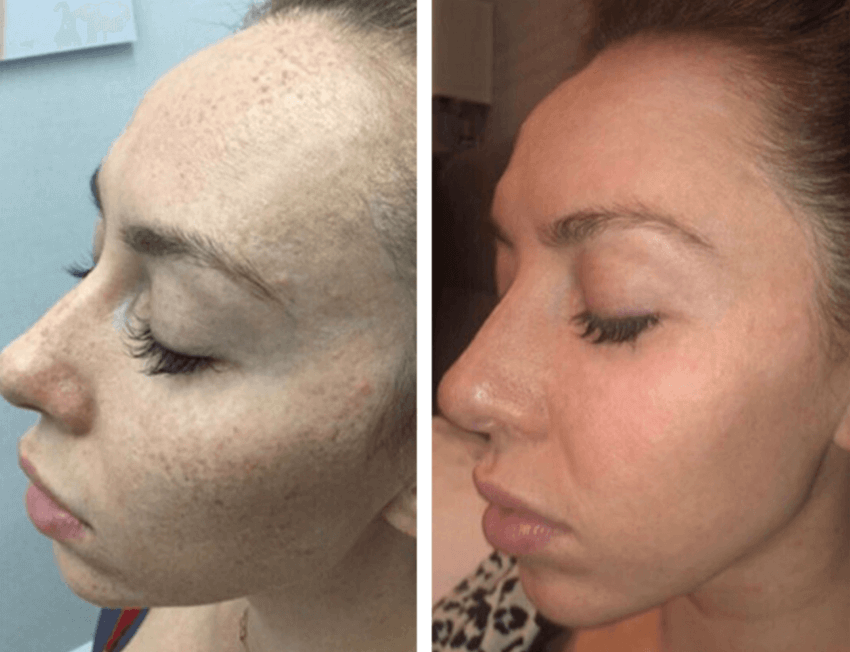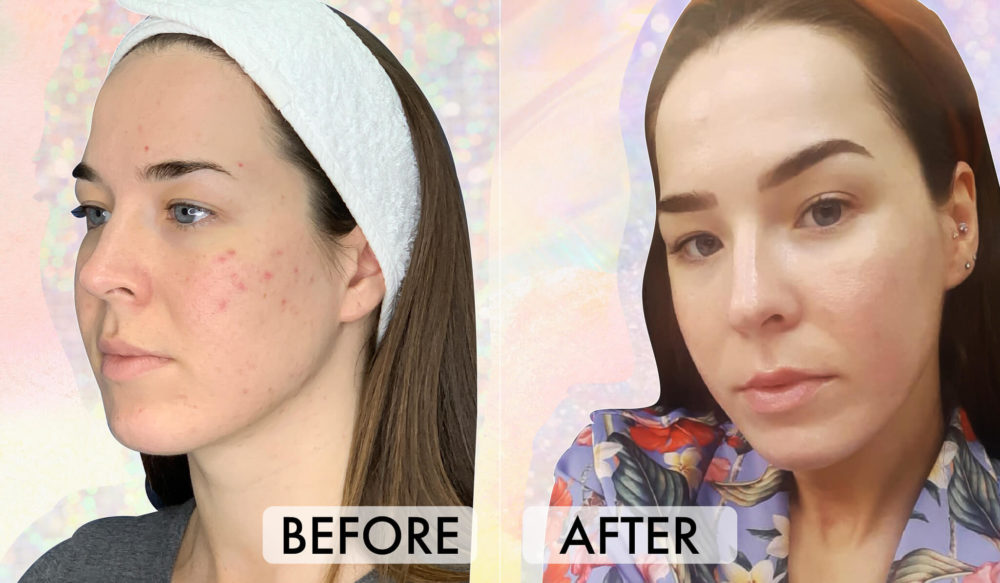How To Fade Sun Spots And Reverse Sun Damage
 via Giphy
via Giphy
If you couldn’t resist spending every day in the sun this summer (us too), then your skin is probably feeling the heat, but don’t stress… We’ve all been there. Not only does September mark the beginning of the summer into fall skincare transition, but it also happens to be #SelfCareAwarenessMonth and that means Sunday – and every other day of the week – should be devoted to self-care. Honestly, we can’t think of a better way to spend a month than masking, skincare multi-tasking, and working on our glow-up game, how ‘bout you?
Sun damage can come in all shapes, shades, and sizes, but some of the most irritating and quasi-concerning signs are dark spots (tan, brown or black) on the face, décolletage, shoulders, backs of hands, and upper back, newly formed fine lines, or dry, scaly patches, also known as actinic keratoses.
Aside from being a real B to deal with (vanity wise), sun damage is no joke and should be addressed immediately, so you don’t run the risk of it worsening and developing into skin cancer later on. That’s why we turned to the top derms, plastic surgeons, and estheticians to tell us how to help our poor, in need of TLC epidermis. From lasers like Fraxel and PiQo4, to microneedling with radiofrequency and the IPL “photo facial,” to vitamin C serums and retinoids, here’s the 411 on what really works, the results you can expect, and what it’ll cost you.
Treatment 1. Fraxel
According to Dr. Howard Sobel, NYC-based cosmetic dermatologic surgeon and director of Sobel Skin, the Fraxel DUAL 1550/1927 Laser is one of the best treatment options for fractional resurfacing of the face, neck, chest, and hands. “It’s very popular in general, but many of our patients start to request this right as the summer ends since its works to reverse sun exposure via microscopic laser columns that penetrate deep into your skin,” he explains.

The before and after results of Fraxel laser
Source: Sobel Skin
“Since the laser treats only a fraction of tissue at a time, it leaves the surrounding tissue intact, which helps jump-start the healing process.” Fraxel is also a buzzy beauty treatment with a cult-like following because it reduces the appearance of stubborn hyperpigmentation, sunspots and pre-cancerous areas on the skin, in addition to stimulating the growth of healthy skin cells from the inside out.

The before and after results of Fraxel laser on the hands
Source: Sobel Skin
The entire procedure takes about 20 to 30 minutes to perform (and the pain level is probably an 8 out of 10 TBH), but no pain, no gain! Some peeling, flaking, and redness are typical for the first few days post-Fraxel as the old, damaged skin needs to shed itself for the new, fresh skin to take its place. Results vary by individual, but can usually be seen after a few weeks to a month. Repeat treatments may also be needed, depending on the level of sun damage.
Cost: $1,500 to $2,500 per treatment
Treatment 2: PiQo4 Laser
Aptly dubbed “the eraser,” the PiQo4 Laser is another great option to improve skin tone and reverse the signs of summer damage on the face and chest. “This breakthrough laser is ideal for isolated hyperpigmented spots, sun spots, and melasma, and rather than using heat, it uses acoustic energy to produce more collagen in the skin,” says Dr. Sobel. And if you have more melanin in your skin, good news for you, since it’s safe to use on all skin types. “Darker skin tones are traditionally more difficult to treat – due to the high rate of rebound with post-inflammatory hypopigmentation (when the skin lacks color) – but PiQo4 is a revolutionary laser that offers a new approach to removing pigmentation,” he adds.

The before and after results of PiQo4 Laser
Source: Sobel Skin
Cost: $500 and up, per treatment
Treatment 3: Vitamin C + Retinol
While in-office treatments are crucial to replenish après-soleil skin, so is a proper at-home skincare routine. “When it comes to treating your skin post-sun, you need to focus on exfoliation to remove the dead skin build-up and hyperpigmentation resulting from sun exposure and additionally, you need to restore hydration within the skin since the sun can cause dehydration,” says Dr. Imber. Vitamin C serum and retinol will help with this. Youth Corridor’s Ultimate Antioxidant C Boost Serum, $195 will enhance your skin’s own rejuvenation process and reverse sun damage – thanks to melatonin and vitamin B3 – while a retinoid, like the RetinUltimate Transforming Gel, $450, applied nightly can virtually iron away fine lines and smooth your visage until it feels like a polished stone. AKA #skingoals. Check out skincare brand The Inkey List, who have some affordable retinol and vitamin C products starting at just $10!
Treatment 3: Intense Pulsed Light (IPL)
If your pain threshold isn’t the highest and you don’t want to spend a fortune, another viable option is a treatment called Intense Pulsed Light (IPL) or “The Photo Facial” as it’s referred to in the skincare industry. Adriana Martino and Marisa Martino are the founders of one of Hailey Bieber’s fave med spas, SKINNEY Medspa, and they love this in-office treatment to target sun damage and melasma (those not so cute gray-brown patches on the skin). It can also minimize redness from broken capillaries and rosacea. The best part? There’s no downtime.

A before and after of the results of IPL treatment on the chest
Source: SKINNEY Medspa
1-5 treatments (spaced out every 4-6 weeks) are recommended and the procedure takes less than 30 minutes. Think of it as a little lunchtime light beam to bump up your glow meter. “IPL works by lifting the dark spots and bringing your skin back to a more superficial state, to flake off as your body builds new skin naturally,” say the Martino sisters. And considering you can see a significant difference after 5-7 days post-procedure, it sounds like a fall skincare must to us. They’re also quick to point out IPL can be used to treat some pre-cancerous lesions, but you should consult with your dermatologist prior to get a proper screening.
Cost: $250-$400 per treatment
Treatment 4: Dermaplaning and Chemical Peels
To restore your skin’s baby face status and get rid of unwanted scaly cell build-up that leads to uneven tone and texture, Gerald Imber, M.D., plastic surgeon and director of New York City’s Youth Corridor Clinic suggests a deep exfoliation treatment (like dermaplaning) with a light chemical peel.
“Dermaplaning uses a blunt scalpel to physically scrape off layers of dead skin cells and then a light chemical peel is applied to the skin to further the exfoliation process,” he explains. Before you freak at the thought of Samantha Jones leaving the derm with a red, blotchy, hot mess face, consider this: chemical peels have come a long way. There are varying strengths of chemical peels and the strength determines the type of downtime you will have, but Dr. Imber’s No-Peel Peel yields impressive results without the shedding – or horror movie character connotation – associated with most peels.
View this post on Instagram
This treatment is not intended to be painful and at most, you may feel a slight tingle with the chemical peel. Totally manageable. The biggest take-away is that your skin will show fewer signs of discoloration and surface irregularities, and appear brighter after a series of three treatments at the same time. Sign us up. Find out more about dermaplaning here.
Cost: $300 and up, per treatment
Treatment 5: Microneedling With Radio Frequency
Robyn Gmyrek, M.D. is a board-certified dermatologist at Union Square Laser Dermatology in Manhattan and when it comes to reversing sun damage and treating aged skin, she relies on the power of microneedling radiofrequency devices. “Aged skin in its most extreme case has both excess brown pigmentation (sun spots) as well as some blotchy redness from broken blood vessels on the face or sun-exposed areas. We also see a texture change to the skin, which is due to both collagen and elastic tissue loss and damage,” she says.
Microneedling with radiofrequency literally creates controlled wounds in the skin – when small needles penetrate the skin and deliver radiofrequency energy at the deepest point. And while we’re sure you’ve seen plenty of at-home micro-needling devices, those don’t go nearly as deep as the professional in-office tools do. Radiofrequency heat, in turn, stimulates new collagen and elastic tissue, thus improving texture and also tightening the skin. Basically, it’s the holy grail of skincare treatments when it comes to tricking your face into aging backward.
It is a bit of a to-do, however. The treatment requires one hour of topical numbing and takes around 15 to 20 minutes. You’ll also probably leave with some marks and redness from the needle entry for 24 to 48 hours, but the recovery is quick. Dr. Gmyrek suggests three treatments monthly to see visible results, which take about 60 to 90 days to become apparent, as this is the time frame for new collagen growth.
Cost: $1,500-1,750 per treatment
Treatment 6: Fractionated Carbon Dioxide Laser
Though fractionated CO2 laser treatments work very well, they do require more recovery time according to Dr. Gmyrek. “The carbon dioxide lasers are ablative, which means that they are able to ablate or destroy microscopic areas of skin as we treat it,” she explains. “Because this laser causes more wounding to the skin, there is also more wound healing and more collagen that is put down by the body leading to a better result.” In short, non-science-y terms, this laser is not your “lunchtime lift” in and out deal. It requires several days of wound care after the treatment to prevent infection and one to two weeks of recovery time, depending on the treatment and the patient. “Patients will often also require topical numbing cream, as well as injected lidocaine for the treatment, and one to three treatments (spaced six months to a year apart) are recommended,” she advises.
Cost: $5,000 per treatment
The most important thing you can do to treat and prevent sun spots is, of course, wear sunscreen daily! Find out why sunscreen is so important and see the huge impact it can make here.























Leave a comment